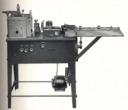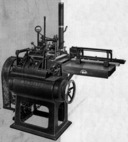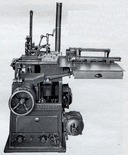
Monotype Lead & Rule Attachment
The casting of strip material on all American and English Monotype machines was accomplished using the "fusion casting" technology invented by Amos L. Knight in 1914. This technology differed fundamentally from the continuous strip-casting invented by Benjamin S. Elrod in 1917.
Monotype's fusion-casting capability for strip material was offered first as an attachment to the basic Monotype caster (see the section on Monotype Machine Names for a discussion of the two variations and other required attachments). This technology was also incorporated into Monotype noncomposing typecasters (such as the Giant Caster) and into dedicated stripcasting machines (such as the Material Making Machine and the (very rare) Junior Material Making Machine).
This Notebook contains material specifically on the Monotype Lead & Rule Attachment. It should be read in conjunction with other Monotype literature on either the Composition Caster or the Type-&-Rule Caster (depending on what you have).

Elrod
The Elrod is a humble and often ignored machine, but it is a technological wonder which continuously casts strips of solid material, of indefinite length, from liquid typemetal. This is Space Age technology from 1917.

Universal (Horn)
This was a clone of the Elrod, produced just after the patents which defined the modern Elrod (Models E & F) expired.

Monotype Material Making Machine
A dedicated fusion stripcasting machine. Brochure, manuals, and parts list.

Monotype Junior Material Making Machine
This machine was not successful. Little is known about it, and none are known to have survived.
Note: There are a very few references (three at least) to a Lanston Monotype "Lead, Slug-&-Rule Caster." While its name would certainly suggest that it was a material making machine, one of these references (a specimen book listing matrices for it) strongly suggests that it was in fact a variation in the equipment of the basic Monotype Caster. I've covered it, therefore, in a subsection of the Type-&-Rule Caster Notebook .
Various other Monotype machines could operate both in "fusion" mode to cast continuous material (and so naturally would be treated here) and in "non-fusion" mode to cast individual types, but could not cast composed matter (and so naturally would be treated in Noncomposing Typecasters ). Because it is easier to cover a single machine in a single section, I'll cover these machines there. They include the Type and Rule Caster, Giant Caster, and Supercaster.
The regular Monotype Composition Caster, treated in Composing Typecasters, had a "Lead and Rule" attachment, but by the time you added it and its prerequisite attachments, you'd basically converted the machine into a Type and Rule Caster which had retained its ability to cast composition.

Koike
Post-WWII. [NOT DONE]
Koike Manufacturing Co., Ltd. built what is perhaps the most diverse range of hot metal equipment of any company in history. Besides this Elrod-derived stripcaster, the machines they built included:
For a general discussion of the Koike Manufacturing Company and its founder KOIKE Rinpei, see the Notebook on the a Koike Automatic Type Caster.

Taylor & Watkinson
[NOT DONE] Cited in Millington, Roy. Stephenson Blake: The Last of the Old English Typefounders. New Castle, DE and London: Oak Knoll Books and The British Library, 2002. (p. 99): "In 1900 they [Stephenson, Blake] acquired a machine patented and dveloped by Taylor and Watkinson which cast leads, clumps and other spacing material in continuous strip form." Millington indicates that this allowed Stephenson, Blake to drive all other British foundries out of the strip material business.

The Thompson as a Stripcaster
[NOTHING YET] I believe that the Thompson had a (now extremely rare) stripcasting attachment (the last one known to exist was destroyed with Harry Weidemann's typefoundry at its loss in 1982). However, I want to treat of the Thompson all in one location, so this present link is up and over to the main Thompson Notebook.
[Add early machines from Huss.]

Mellen
[NOTHING YET] [US patents 1,139,885, issued 1915-05-18, filed 1914-05-16, and 1,139,887, issued 1915-05-18, filed 1914-11-28. Grenville Mellen. Interesting technically because it used a series of moving molds, and historically because it predated the Elrod.]

Brasted ("Mold Disk" Machine)
[NOTHING YET] [US patent 1,507,456, issued 1924-09-02, filed 1918-09-13. Clair H. Brasted. This patent was assigned to the Ludlow Typograph Company, but this machine is unlike any Elrod they ever produced.

Breit - Stripcasting with Ornament
[NOTHING YET] [US patent 1,422,532, Issued 1922-07-11, filed 1921-05-21. Martin M. Breit. Continuous stripcasting, with rollers after the mold to impress a typographical design on the strips.]

De Nisson & Christie - Dotted Rule
[NOTHING YET] [US patent 1,429,720, issued 1922-09-19, filed 1919-07-30. [Attachment for Monotype stripcasters to form the output into dotted rule. Given the filing date, I wonder if this wouldn't have also specified Elrods if they'd known.]

Dittman
[NOTHING YET] [US patent 1,444,905, issued 1923-02-13, filed 1921-11-03. Cutting mechanism controlled by the strip itself.]

Faupel Vapor Oiler
[NOTHING YET] [US patent 1,466,125, 1923-08-23. Charles F. Faupel.] [Not an entire machine, but just an oiler. Delivers oil in vapor form, not liquid.]

Coats
[NOTHING YET] [US patent 1,503,479, 1924-08-05. Vertical continuous casting. Lubrication through mold itself. Note that this is for general casting of metal rod (and plate), not necessarily the casting of printing material or even specifically the casting of typemetal.]

Bisey
[NOTHING YET] [US patent 1,568,047, 1926-01-05. Sunker Abaji Bisey (UK citizen resident in NY) Adjustable mold. Pulling via a double "conveyor belt" of spring-loaded cups.]

Dahl
[NOTHING YET] [US patent 1,671,088, 1928-05022. Three plungers for smoother flow.] [US patent 1,946,488, 1934-02-13. Rollers to pull material.]

Eldred
[NOTHING YET] [Various US patents, including: 2,135,465 (1938-11-01), 2,048,733, and 1,868,099 and others still pending as of 1938-11-01.] [Continuous casting of metal in general. Curious theories of heat. The inventor appears to have been unaware of the Elrod.]

Honig
[NOTHING YET] US 2,891,660 1959-06-23, for an improved strip puller. This appears to be simply a component improvement, not a complete machine. Curiously, this patent was not assigned to the Universal Mono-Tabular Corp. (or to anyone else), makers of the Universal Strip-Caster under the Horn patents (even though they also made Honig's Multiple Broach and those patents of his were assigned to them).

Anton & Edward Narrow
[NOTHING YET] [Like the Universal (Horn) machine, this appears to be an attempt to re-invent the Elrod at the moment of expiration of the 1931 Hedly patent.] [US patents, including: 2,531,290 issued 1950-11-21, filed 1948-04-12. Anton H. Narrow. stripcasting machine. 2,579,691 issued 1951-12-25, filed 1948-12-05. Anton H. Narrow. mold. 2,807,843, issued 1957-10-01, filed 1956-01-23. Anton H. Narrow and Edward A. Narrow. Lubricator.]

Shidler - Roller Die
[NOTHING YET] [US patent 2,748,922, issued 1956-06-05, filed 1954-02-23. [Roller die for forming designs on rules. Quite like De Nisson / Christie and Breit.]
Shidler's 1954/1956 patent references not only the Elrod, but also the "Universal" and the "B and M" machines as stripcasters. What was the "B and M"?
The Linotype Lead and Rule Caster, although a "material maker," was really a linecaster as it produced discrete slugs of material rather than continously formed strips.
US Patent 1,088,171 (1914-02-14, Adam Helmer Pherson) describes, somewhat schematically, apparatus for casting metal tubes continuously.
All portions of this document not noted otherwise are Copyright © 2008-2009 by David M. MacMillan and Rollande Krandall.
Circuitous Root is a Registered Trademark of David M. MacMillan and Rollande Krandall.
This work is licensed under the Creative Commons "Attribution - ShareAlike" license. See http://creativecommons.org/licenses/by-sa/3.0/ for its terms.
Presented originally by Circuitous Root®
Select Resolution: 0 [other resolutions temporarily disabled due to lack of disk space]